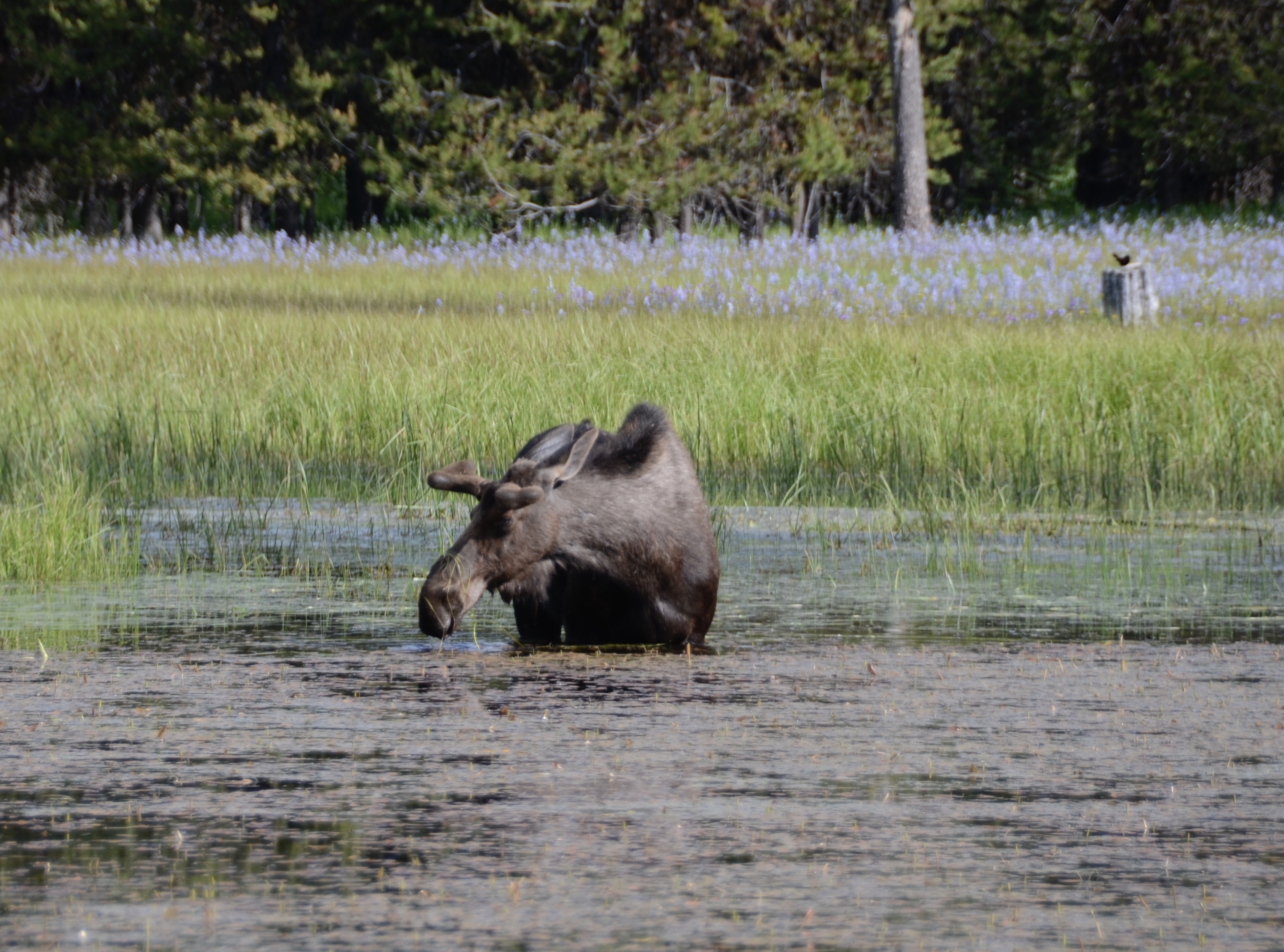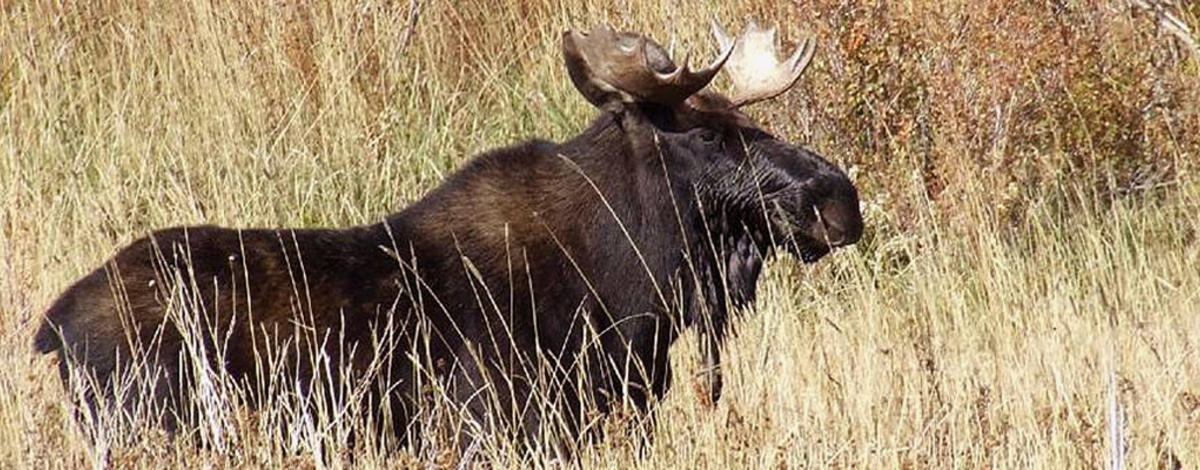Opportunities for moose hunters to harvest one of Idaho’s most sought-after trophy species will be fewer in 2019-20 in an effort by Fish and Game wildlife managers to address declining populations in much of the state.
The Fish and Game Commission in January approved a statewide reduction of 171 moose tags, with decreases in antlered and antlerless tags in the Panhandle, Clearwater, and Southeast regions, as well as a decrease in antlered tags in the Upper Snake Region. Statewide, antlered tags were reduced from 669 in 2017-18 to 560 in 2019-20, and antlerless tags were reduced from 136 to 74.
“We don’t take lightly that there’s a 16 percent reduction in antlered tags, and a 46 percent reduction in antlerless moose tags across the state,” Fish and Game Director Ed Schriever said. “Certainly, we would like to be talking about increases in tags, but it is simply not biologically supported.”

Harvest data tells the story
Moose are difficult for biologists to monitor. They are widespread, found in low densities, and often live in places that make counting them from the air impractical. Historically, Fish and Game biologists have relied on various information to gauge the trends of Idaho’s moose population.
That information includes:
- Hunter success, which is the number of hunters who successfully filled their tags
- Hunter effort, which is the number of days it took a tag holder to harvest a moose
- Antler size (age) of moose harvested
Depending on how those numbers change from year to year, wildlife managers adjust permit levels accordingly, while also factoring in public input and field observations.
Moose populations in Idaho steadily increased into the early 2000s. They had greatly expanded their range and numbers throughout the state since the 1970s, and also expanded west into Washington and northeastern Oregon.
Statewide, moose tag numbers in Idaho increased during every biennial season setting cycle between 1990 and 2004, when the total number of tags – both antlered and antlerless – peaked at 1,235. In 2010, that number was 1,027, and it has been falling since.
Since the peak in the 2000s, harvest records, field staff and hunter reports indicated that many regional moose populations in Idaho were stable or declining.
Fewer animals mean less hunting opportunity
North Idaho was the first area where Fish and Game biologists noticed the moose population trending down. Fish and Game wildlife managers reduced tag numbers in the Clearwater Region in 2001, responding to lower hunter success rates and smaller antler spreads.
Using those same metrics, biologists reduced tags in the Clearwater Region again in 2005 and 2009, along with significant reductions in Southeast Idaho and the Upper Snake regions in those years, respectively.
Since 2009, statewide moose tag numbers have decreased in four of the past five two-year season setting cycles leading up to the most recent one, which saw the largest proportional decrease in the past 30 years. Ironically, moose numbers increased in areas of the state once considered less-optimal habitat, such as southern Idaho, while numbers declined in parts of the state considered prime habitat.
Moose numbers declining across the U.S.
Moose populations have declined in parts of the country since the 1990s, and concerns escalated since the early 2000s. Eastern moose populations were the first to experience significant reductions in numbers. Moose populations in the West appeared to fare better than their eastern counterparts, but the Rocky Mountain states eventually began seeing similar declines.
“Many things affect moose populations, and it is not just Idaho – the declines span the entire southern extent of their range,” Schriever said.
The reintroduction of wolves in the mid 1990s affected moose populations, but like most things wildlife related, there’s rarely one simple answer.
“We’re certain wolf predation is playing a role, and we are addressing that with more liberal wolf hunting and trapping seasons,” Schriever said. “But we’re also seeing moose declines in areas that have few, or no, wolves, and shrinking moose populations are not unique to Idaho.”
Elsewhere in the country, researchers have identified a wide range of possible factors potentially contributing to moose declines, some of which include climate change-related shifts in forage quantity and quality, changing parasite prevalence, and impacts of predation (especially wolf-related).
Researchers in Idaho and beyond look for answers
Dwindling populations of moose in the western United States prompted wildlife officials in the region to pool their resources. Biologists from Idaho and neighboring states – including Montana, Wyoming, Utah, Washington and Nevada – began working together in 2013 searching for answers to the declining numbers. Each state is looking into different factors that could contribute to moose population declines and communicating the results of their research.
Idaho’s initial research project, which it recently completed, focused on nutrition. Other states looked into adult survival, pregnancy, and how body condition relates to pregnancy and the number of calves born. Idaho’s nutrition project looked at how changes in habitat altered the nutritional landscape for moose by decreasing the amount of high-quality forage.
“We are working together to find out what is causing this to happen,” said Wildlife Staff Biologist Hollie Miyasaki said. “We have a whole list of things that could be contributing, and they probably all are.”
Idaho is also working independently to better understand its own moose populations. In 2013, Fish and Game biologists collected 460 blood, liver, and fecal samples from moose harvested by hunters, which they used to evaluate micronutrients and parasites. Biologists are planning to collect samples from moose harvested in the 2019 hunting season. This time around, they are interested in looking at pathogens, parasites, and blood work.
Idaho wildlife managers also plan to get better estimates of moose populations by using remote cameras to estimate abundance and cow-calf ratios. They will also be radio collaring adult female moose in several parts of the state to assess survival and – if one dies – determine what killed it. During capture and collaring, biologists will also gather health information from biological samples and look at body conditions.

